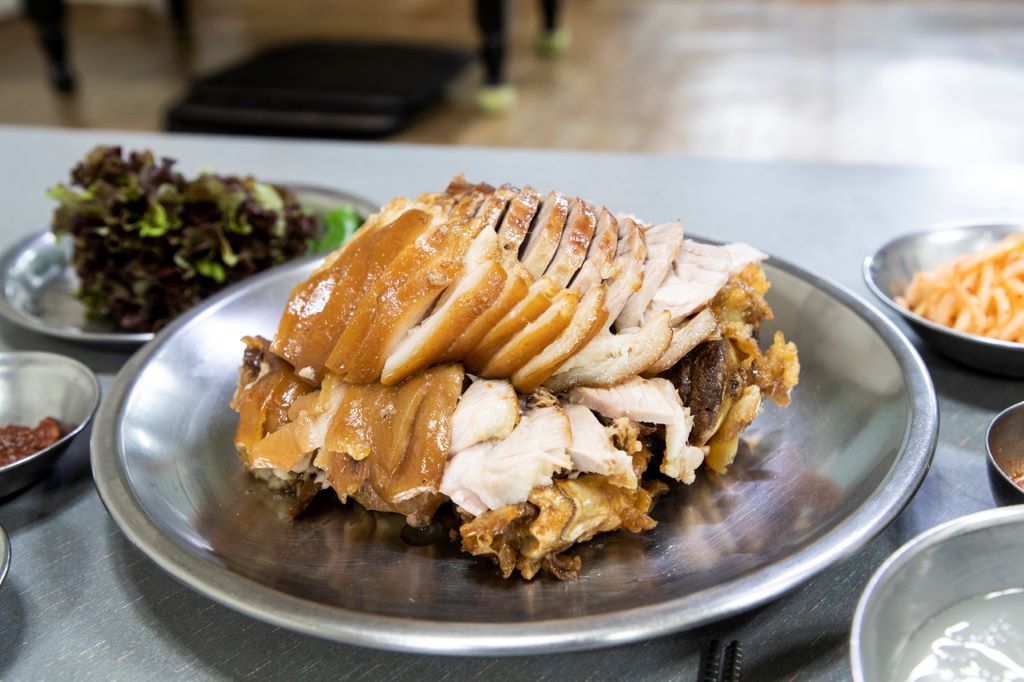
Jokbal ⓒ한국관광공사 사진갤러리-한국관광공사 이범수
What’s a Jokbal?
Jokbal (족발):
Jokbal is a popular Korean dish made from pig’s trotters that are seasoned, braised, and then sliced before being served. This dish has a rich history that dates back several centuries, reflecting the influence of both Korean culinary traditions and Chinese cuisine.
Chinese Influence:
The origins of It can be traced back to the Chinese dish “zhǔjiǎo” (猪脚), which also features braised pig’s trotters. During the Goryeo Dynasty (918-1392) in Korea, Chinese culinary influences began to make their way into Korean cuisine, and It is believed to be a result of this cultural exchange.
Transformation in Korea:
While It was influenced by the Chinese dish, Koreans adapted it to suit their own taste preferences and ingredients. The process of making it involves thoroughly cleaning the pig’s trotters and then simmering them in a flavorful broth with various seasonings, including soy sauce, garlic, ginger, and aromatic spices. This slow-cooking process results in tender, flavorful meat that is both savory and slightly sweet.
Historical Significance:
In Korea, this has been enjoyed for centuries and has been associated with festive occasions and celebrations. It was considered a special dish often enjoyed during holidays, birthdays, and other significant events.
Popularization and Modern Era:
Over time, It became more widely available and accessible to the general population. Street vendors and restaurants began to offer jokbal as a popular dish, both for special occasions and everyday consumption. One’s popularity continued to grow, and it became a beloved comfort food enjoyed by people of all ages.
Variations and Accompaniments:
While the traditional jokbal is braised and served as sliced meat, there are variations that include seasoned or spicy versions. In addition, It is often accompanied by side dishes such as pickled vegetables, kimchi, and garlic.
Cultural Significance:
It’s enduring popularity speaks to its cultural significance in Korean cuisine. It represents a harmonious blend of traditional Korean flavors and Chinese culinary influences, showcasing how different cultures can come together to create a beloved dish that stands the test of time.
Today, it remains a popular dish in Korea, enjoyed by locals and visitors alike. It’s a dish that reflects both the history and evolution of Korean cuisine, making it an integral part of the country’s culinary heritage.
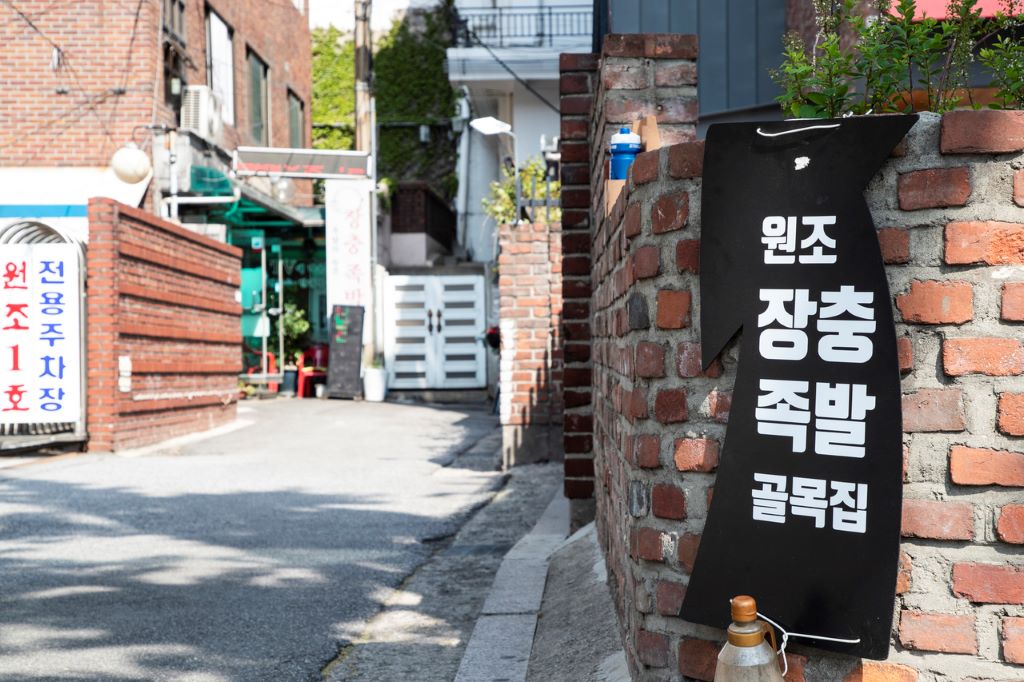
Jokbal Golmok in Jangchung Dong in Seoul
Jangchung Jokbal Golmok, also known as Jangchung-Dong Jokbal Street, is a renowned food street in Seoul, South Korea, famous for its specialized restaurants and vendors that serve one, the beloved Korean dish made from braised pig’s trotters. This street is located in the Jangchung-dong neighborhood, near the Dongdaemun area. Here’s more about the famous Jangchung Jokbal Golmok:
Overview:
Jangchung Jokbal Golmok is a culinary destination that attracts locals and tourists alike who are looking to enjoy high-quality and flavorful one. The street is lined with numerous it’s restaurants and eateries, each with its unique preparation methods, seasonings, and accompanying side dishes.
Highlights:
Variety of Choices: Jangchung Jokbal Golmok offers a diverse range of it’s options, from classic preparations to modern twists and variations. Visitors can choose from a selection of restaurants based on their preferences for flavor, texture, and ambiance.
Atmosphere:
The street has a vibrant and bustling atmosphere, especially during peak dining times. The scent of braised pig’s trotters fills the air, creating an inviting ambiance that draws people in.
Side Dishes: In addition to the that itself, many restaurants along Jangchung Jokbal Golmok offer an array of side dishes and accompaniments that enhance the overall dining experience. These side dishes often include pickled vegetables, kimchi, radish, and more.
Cultural Experience: Exploring Jangchung Jokbal Golmok is not only a culinary experience but also a cultural one. It’s an opportunity to immerse oneself in Korean food culture, witness local dining customs, and engage with a beloved dish that holds a special place in Korean cuisine.
Famous Restaurants:
While many establishments along Jangchung Jokbal Golmok are popular, a few restaurants have gained particular recognition for their jokbal offerings. One well-known restaurant in the area is “Jangchung-Dong Jokbal,” which has been praised for its delicious and authentic jokbal dishes.
Visiting Jangchung Jokbal Golmok:
If you’re a fan of jokbal or interested in experiencing this iconic Korean dish, Jangchung Jokbal Golmok is a must-visit destination. It’s a chance to explore the rich flavors, culinary traditions, and vibrant food scene of Seoul. Whether you’re a local seeking comfort food or a traveler looking to savor a unique culinary adventure, Jangchung Jokbal Golmok is sure to offer a memorable experience.
Hometown Food of North Korean Displaced People
After the Korean War broke out in 1950 and divided into North and South Korea, North Koreans who could not return to their hometowns, or ‘displaced people’, lived in Jangchung-dong.
Those who are home to Pyeongan-do and Hamgyeong-do began to make and eat pig’s feet, which are food for important events such as weddings, and as a large sports facility called Jangchung Gymnasium was built nearby, many events were held here, making local food famous
Cooking Method
Making jokbal, the popular Korean dish of braised pig’s trotters, requires time, patience, and attention to detail. Here’s a basic recipe to guide you through the process of making jokbal at home:
Ingredients:
2-3 pig’s trotters (cleaned and hair removed)
Water for blanching
1 onion, peeled and quartered
1 piece of ginger (about 2 inches), sliced
4-5 cloves of garlic, smashed
1/2 cup soy sauce
1/4 cup rice wine (or mirin)
1/4 cup brown sugar
1 teaspoon black peppercorns
1 cinnamon stick
2-3 star anise
Water, as needed
Optional: hard-boiled eggs, cooked chestnuts
Instructions:
Blanch the Trotters:
Place the cleaned pig’s trotters in a large pot of boiling water.
Allow them to boil for about 10 minutes to remove excess impurities.
Drain and rinse the trotters thoroughly under cold water.
Prepare the Broth:
In a large pot, combine the blanched trotters, onion, ginger, garlic, soy sauce, rice wine, brown sugar, black peppercorns, cinnamon stick, and star anise.
Add enough water to cover the trotters.
Braise the Trotters:
Bring the mixture to a boil, then reduce the heat to a simmer.
Cover the pot and let the trotters simmer for 2-3 hours, or until the meat is tender and easily separates from the bone.
Check the water level occasionally to ensure the trotters are submerged. Add more water if needed.
Cool and Slice:
Once the trotters are tender, remove them from the broth and let them cool slightly.
While the trotters are still warm, use a sharp knife to carefully slice the meat into bite-sized pieces.
Serve:
Arrange the sliced jokbal on a serving plate.
If desired, you can also include hard-boiled eggs and cooked chestnuts as accompaniments.
Optionally, you can reduce the broth until it thickens slightly to create a dipping sauce.
Enjoy:
Jokbal is often served with various side dishes, such as pickled vegetables and kimchi.
Dip the jokbal pieces into the dipping sauce or enjoy them as they are.
Note: Making jokbal requires time and patience, as the trotters need to be braised until they are tender and flavorful. The choice of seasonings and the braising time can vary based on personal preference and regional variations.
Keep in mind that making jokbal at home may be a more elaborate process compared to other dishes, but the end result is a delicious and satisfying Korean delicacy that’s worth the effort.
Recommend to Read >>> 2023 Korean Andong Jjimdak Recipe
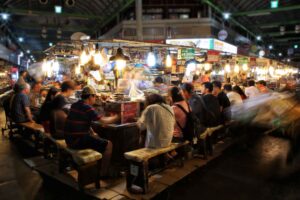

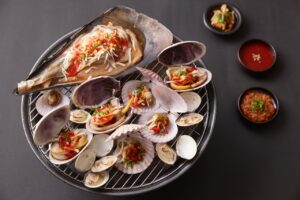

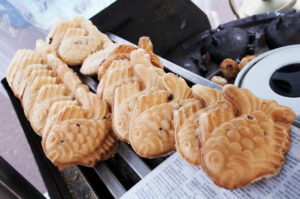
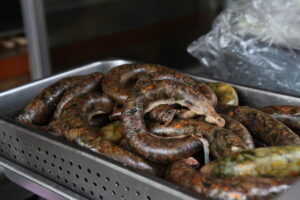
I was more than happy to find this great site. I want to to thank you for ones time for this particularly fantastic read!! I definitely savored every little bit of it and i also have you bookmarked to see new things on your web site.
Thank you for your visiting. Have a good time to read. ^ ^